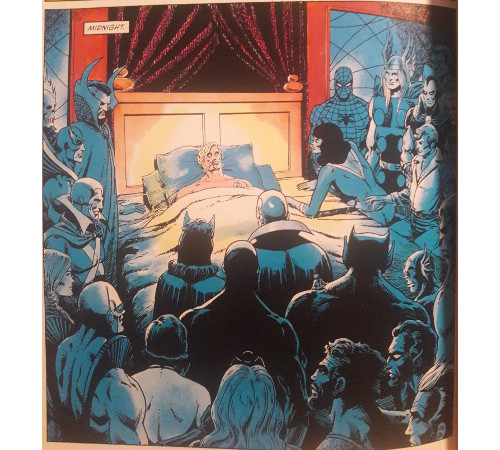Spider-view: The Death of Captain Marvel
Marvel's first-ever graphic novel is a gorgeous tribute to a fallen hero
—by Nathan on May 23, 2020—
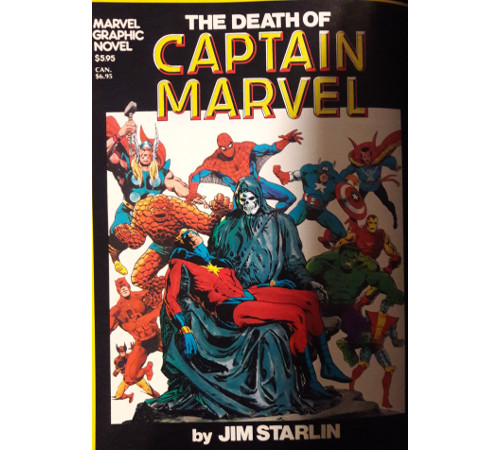
Viewers of the 2019 Marvel Cinematic Universe film Captain Marvel are certainly aware of Carol Danvers and her empowered (in more ways than one) alter ego. Most people probably recall the character of Wendy Lawson, the Kree operative stationed on Earth who developed an experimental warp drive before she was killed by Carol’s mentor, Yonn-Rogg. You may also remember her Kree name: “Mar-Vell.”
Recently, I was surprised to discover how much the film pulled from some of the very first issues that Captain Mar-Vell appeared in. A Kree male in the comics, Mar-Vell first came to Earth as an operative of his people sent to study the planet under the orders of Yonn-Rogg. Betrayed by his superior (who was attracted to the medic that Mar-Vell loved, Una), Mar-Vell was stranded on the planet and spent his first adventure fighting a Kree Sentry attacking a military base where one Carol Danvers was employed, not as a pilot, but as head of security. She would only claim the Captain Marvel mantle years later, far after the story we're examining today.
This is where the film and comics diverge.
I am unaware of Captain Marvel’s history, save two elements: first, his powers were bestowed upon him through gauntlets called the Nega-Bands, which at one point also allowed him to physically trade places with Rick Jones, human sidekick of the Incredible Hulk. For a time, Captain Marvel remained stranded in a dimension called the Negative Zone until Rick clapped the Nega-Bands together, shunting Jones into the Zone while Captain Marvel could zoom around freely until they switched places again. Second, Mar-Vell once battled a villain named Nitro, where he was subjected to a deadly toxin in their first encounter. I know next to nothing about the character save these two details, yet when I got the chance to purchase a copy of a volume containing Marvel’s first-ever original graphic novel, starring the cosmic protector, I leapt at it. The story is held in high esteem by fans today and praised for being simultaneously groundbreaking and heartbreaking. It’s a powerful tale of how a life touches the lives of others and how its end can impact so many.
Oh, and Spidey’s in it. That’s also a reason.
The Death of Captain Marvel
Writer: Jim Starlin
Penciler: Jim Starlin
Issue: Marvel Graphic Novel #1
Publication Date: April 1982
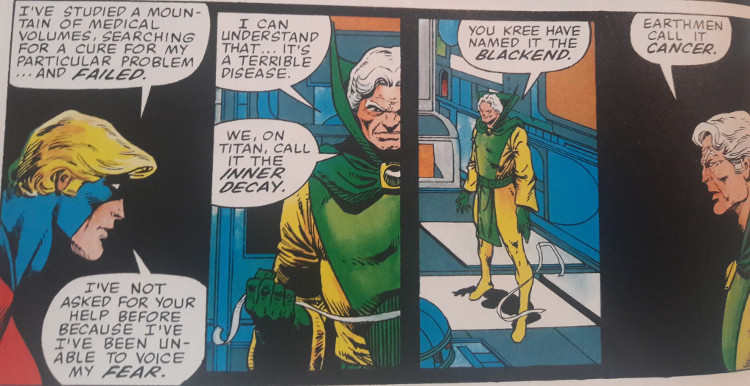
I’m just gonna spoil this right away: the title is legitimate. Mar-Vell really, truly dies in this comic. No last minute saves, no sudden reveals (“Surprise! He was a clone this whole time!”), no time travel hijinks to bring back a younger version of the hero. There’s no metaphor here, there’s no misreading the title...Captain Mar-Vell dies. And, amazingly, he’s never been brought back in any significant fashion. In a world saturated with stories where your Jean Greys and Supermen and Captain Americas and even Jason Todds can’t stay dead for more than a few years, this comic is weighty. Death is final here. No reboots, no resurrections. When Wolverine died a few years ago, I (and, I’m pretty sure, many other comic book fans) snorted to myself and muttered, “He’ll be back, bub.” Sure enough, Logan presently roams the pages of comics once more. But Mar-Vell...save for a few flashback sequences, a couple of ghostly appearances, and a handful of minor “resurrections” that saw him momentarily return to life before shuffling off this mortal coil again...yeah, he’s never fully, solidly returned.
The impact of Mar-Vell’s death is only heightened by the manner in which it happens. After battling a horde of Thanos-worshippers, honoring the name of the then-deceased Mad Titan, Mar-Vell is stricken with a terrible coughing fit that is soon tested and revealed to by symptomatic of a disease the Kree call “Blackend.” In Earth terms, Mar-Vell has contracted cancer. The blow is a heavy one, and while Starlin uses many of his panels to show heroes like Iron Man, Doctor Strange, the Beast, and the Eternal known as Mentor looking into potential cures for their ailing friend, none are successful. Magnificently, Starlin ropes you into the story by depicting how solemnly and staunchly these other heroes strive to assist Mar-Vell--they put their heads together, apply whatever science and magic they’ve learned about, do whatever it takes to help the captain. For a brief second, despite the title’s story and inevitable end, Starlin dangles hope in front of your nose like one would coerce a rabbit with a carrot and a stick. And it’s not meant to be cruel or hopeless; Starlin isn’t trying to unnecessarily boost your confidence for a moment before shattering it. Reading this, I knew the end was coming and saw the heroes’ attempts as merely kind gestures on their part, despite the hopelessness.
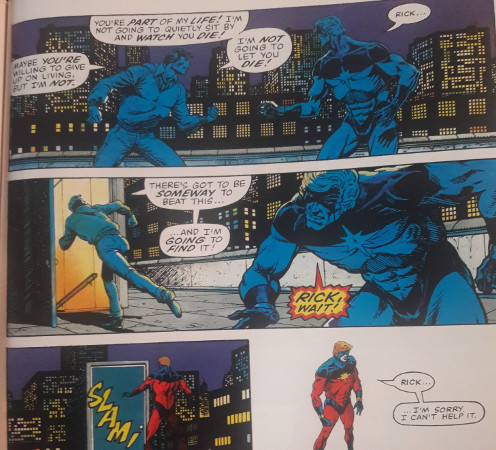
While various heroes band together and scour the galaxies for a cure, Mar-Vell gets his affairs in order. Starlin weaves multiple scenes of Mar-Vell confronting several special people in his life--Elysius, an enemy turned lover who Mar-Vell fell for after Una was murdered by Yon-Rogg; Rick Jones, the friend whom Mar-Vell exchanged places with several times and takes Mar-Vell’s viral death sentence the hardest; Eros, Thanos’ brother, whom Mar-Vell requests to take care of Elysius following his passing. These conversations are fraught with a vast emotional range. Elysius’ tears, depicted wordlessly by Starlin, come shortly before Rick’s rage, disbelief, and pleas to the Avengers to do something to help Mar-Vell. Starlin depicts other people and races on planets far and wide wordlessly hearing and accepting the grim news, either with sorrow or callous joy. Suddenly, this character, this Mar-Vell, who seems to have always been third-tier, is one of the most important men in the galaxy.
And it’s these reactions which make the book feel real. For myself, I don’t have a deep history with cancer--I know of a handful of people personally who suffered with it, some of whom battled it into remission, one person who was tragically lost to it. But for those people, I was never present for most of the treatments they underwent, the painful days they experienced, or the moments of hope that encouraged them as they fought. Unable as I am to accurately portray the varied emotions of an individual dealing with cancer or the response of those coping with either the fear of having a loved one face cancer or the loss of a loved one ravaged by the disease, I can still estimate the emotions involved or feel at least a semblance of what those emotions are. Worry, rage, disappointment, hurt, comfort, peace, loss, hope, joy. Starlin’s characters possess these emotions in spades, from the heroes wading through research and strategy to seek a cure for Mar-Vell to the friends and loved ones who ponder Mar-Vell’s swiftly approaching end.
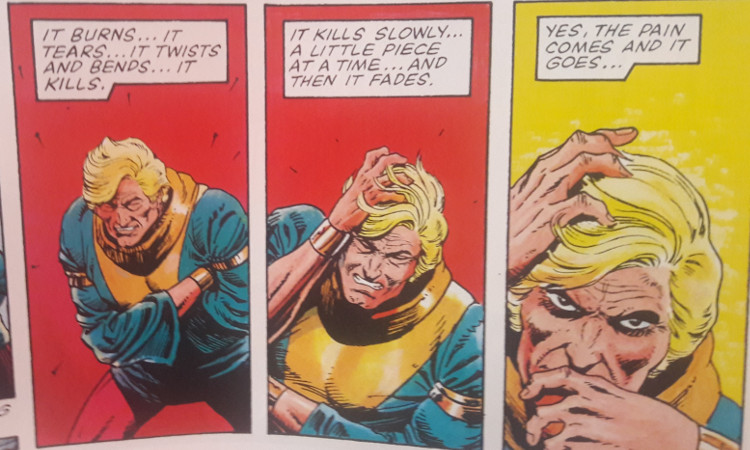
How Mar-Vell deals with the pathogenic sentence given to him also makes the book an insightful read. With others, Mar-Vell is wholly concerned for their well-being in the face of his tragic diagnosis, being as comforting as one can be as a messenger of such news; alone, he flies into a rage as pain strikes him from within, understandably lamenting his lot. He mourns his coming end, disheartened that such a fatal blow is directed, not by one of his several alien foes, but by his own body. Starlin even alters Mar-Vell’s physique as the graphic novel goes on, the captain's strong, muscular form becoming weaker and sunken cheeks replacing his once-strong jaw. Physical pain racks his body while emotional pain assaults his mind.
In his calmer moments, Mar-Vell records his memoirs, an autobiographical account presented lovingly by Starlin. You can tell Starlin has a real appreciation for the character’s life and legacy, laying out his greatest moments and worst defeats in a narrative almost as engaging as Mar-Vell’s present battle. Two splash pages distinctly stand out as Mar-Vell records his account, images where friends and foes alike cluster, representing the sheer number of characters Mar-Vell has interacted with, fought alongside, or defeated in combat. Familiar allies such as Spider-Man (whom Mar-Vell teamed with on at least one occasion in the pages of Marvel Team-Up), the Thing, Adam Warlock, Drax the Destroyer, Iron Man, Captain America, the Vision, the Beast, Rick Jones, Namor, Gamora, Moondragon, and Pip the Troll pop up in the same pages as enemies such as the Controller, the Super Skrull, Annihilus, the Stranger, Quasimodo, Nitro, and Thanos. Death herself appears in the background of one page, an ominous portent of her arrival later in the story.
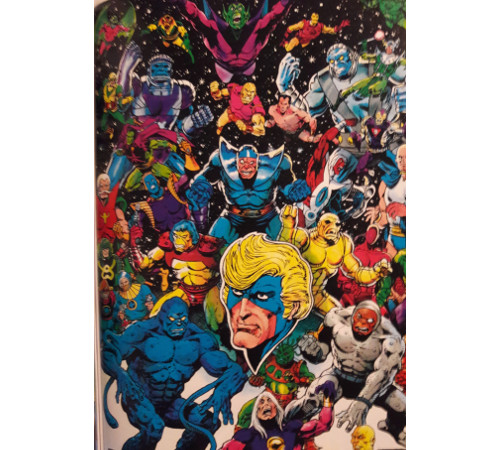
Starlin’s artistic range and love of story are remarkable here; though these are but static images of heroes and villains plastered on the pages, they exemplify the extent of Mar-Vell’s history and all the various characters he’s come into contact with during his intergalactic travels and trials. As someone who knew virtually nothing (and still knows very little) of the hero’s storied history, I was genuinely surprised and intrigued by all the characters he congregated with that I was familiar with as well. I was unaware how far the space-faring captain had gone in his adventures and remarked to myself I wouldn’t mind exploring more of his history, should the opportunity ever present itself.
The emotional weight Starlin injects into his tale carries itself to the very end. After an enfeebled Mar-Vell collapses and ends up bed-ridden, several ships from across the galaxy land at Titan. From these stream a powerful assemblage of heroes (and even a few foes) coming to pay their last respects to Mar-Vell, giving Starlin the opportunity for another wonderful splash page. A ton of people are displayed here, from Avengers to X-Men to other assorted flavors of the superhuman. Spidey sticks to a wall as the Human Torch offers a friendly wave; Iron Man seems to hold back an angry or perhaps distraught Hercules; the Thing looks like he’s reprimanding a young Franklin Richards. In total, 42 characters fill the page, all here for the same reason. It’s beautiful seeing such a remarkable group of people assembled for so important a purpose: saying farewell to a friend one final time.

Spidey is given his own little scene with the captain as others wish Mar-Vell goodbye. Overwhelmed with emotion as he stands beside the captain's bed, the Web-Head leaves the room, much to the consternation of the Thing. Mar-Vell, gracious even in death, lets Spidey go without a word. As Spidey explains to the Beast, he’s struggling with the idea of losing someone as powerful as Mar-Vell to something so random as cancer. Spidey’s reaction frustrated me a little at first, perhaps striking an unnecessarily personal chord. Of all the characters to leave the room in a state of pain, why did it have to be MY favorite hero? Yet that quickly passed as I read Spidey’s conversation with the Beast, helping me realize that Spidey wasn’t acting callous or cold towards Mar-Vell’s plight. He was being very human. I remember the discomfort of being in a hospice room, by the bedside of a quickly fading loved one. The room is charged with emotion, ranging from grief to unease to uncertainty. A discouraging, disquieting, discomforting environment. Being beside a dying relative or friend is an important position to be in, but it’s not an easy place to stay. I fully understand Spidey’s reaction. In his place. I would have acted similarly.
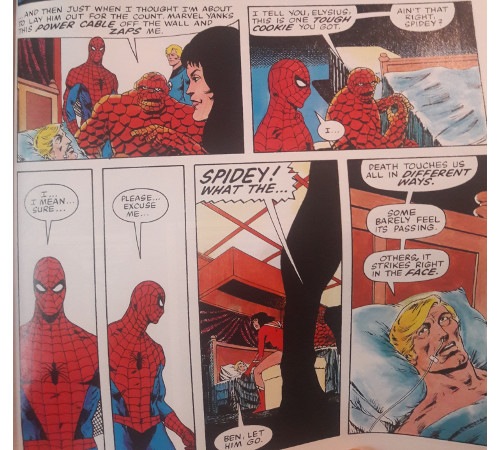
Oddly enough, the actual death of Captain Mar-Vell is perhaps the story’s weakest moment. Though filled with imagery, including a dreamlike interaction between Mar-Vell and the personification of Death to mark his quiet transition from this world to the next, the scene doesn’t feel like the apex of this graphic novel. And maybe it isn’t meant to be. Again, Mar-Vell’s loss isn’t a necessarily heroic one. No explosions, no fisticuffs, no dramatic sacrifice to rescue an ally. Surrounded by friends, Mar-Vell passes. Yet as quiet and unassuming a scene as it is, the death of Mar-Vell is heightened by all that has come before. Without the preceding struggle, without the valiant efforts of his friends, without the verbal autobiography, and without the dramatic visitations from fellow heroes, Mar-Vell’s death wouldn’t be as impactful. The moment of his passing is buoyed by the understanding of genuine loss that accompanies such a tragic moment, the hearts still beating in the room hurt by the silencing of one heart that would beat no more.
I see why this graphic novel is a classic and why fans still read and write about it today. I understand the love Starlin poured into both the character of Mar-Vell and this final story. Starlin is a master of all-things cosmic in the Marvel Universe (we will be exploring another story of his, The Infinity Gauntlet limited series, at a later date), and this graphic novel cements his ability to create a heartrending tale out of a somewhat obscure character. His isn’t a world where heroes just crisscross the stars and battle for the fates of entire planets or solar systems. No, this section of the universe that Starlin touched is still as familiar as our world, with people who live, die, and leave legacies for friends, family, and future generations to follow.
